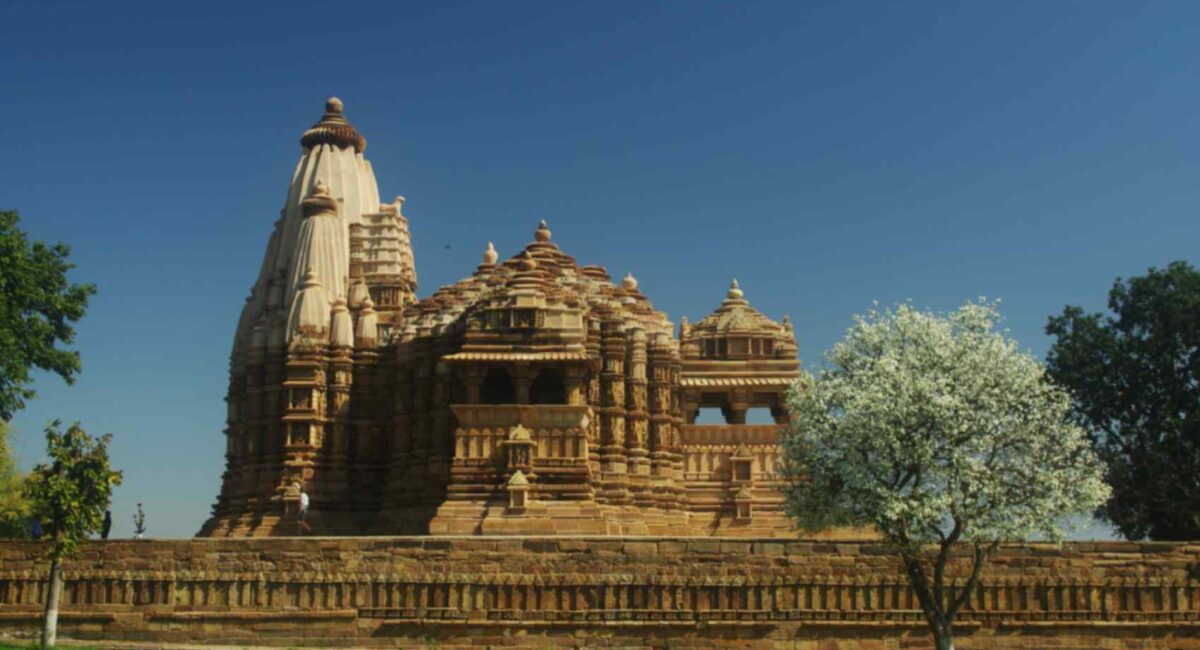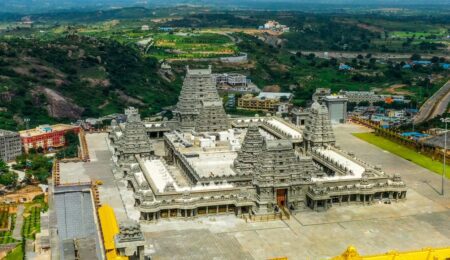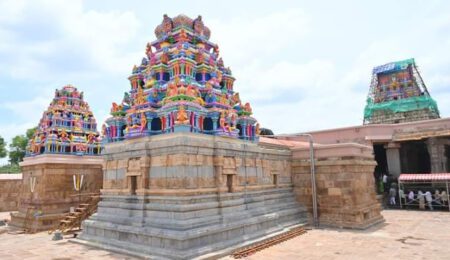Chitragupta Temple Khajuraho: A Sunlit Marvel of Chandela Architecture
Introduction & Overview
Nestled in the heart of Madhya Pradesh, the Chitragupta Temple Khajuraho is a luminous gem in India’s architectural crown. Part of the famed Western Group of Temples, this monument is a rare dedication to Surya, the Vedic Sun God, and a testament to the Chandela dynasty’s devotion to both divine symbolism and artistic excellence.
Unlike the more frequently visited Shiva and Vishnu temples in Khajuraho, Chitragupta Temple offers a unique spiritual experience centered around solar worship. Its east-facing sanctum, ornate sculptures, and Nagara-style architecture make it a must-visit for historians, devotees, and travelers seeking to understand the spiritual and aesthetic pulse of medieval India.
Historical Background
The Chandela Dynasty: Architects of Divine Grandeur
The Chandela rulers, who governed the Bundelkhand region from the 9th to 13th centuries, were prolific temple builders. Their reign marked a golden age of temple architecture, with Khajuraho emerging as a sacred city adorned with over 85 temples of which only 20 survive today.
The Chitragupta Temple was constructed around 1020–1025 CE, during the reign of King Dhanga or his successors. This period saw a flourishing of Hindu temple architecture, with a strong emphasis on spiritual symbolism, erotic art, and cosmic geometry.
Why “Chitragupta”?
The temple’s name has puzzled historians. While it is dedicated to Surya, the Sun God, it bears the name of Chitragupta, the divine accountant of Yama (the god of death). Some scholars suggest that the temple may have originally honored Chitragupta and was later rededicated to Surya. Others believe the name reflects a symbolic connection between divine judgment (Chitragupta) and illumination (Surya)—both forces that reveal truth.
This duality adds a layer of mysticism to the temple’s identity, making it not just a place of worship but a philosophical space where light and karma converge.
Architectural Features of Chitragupta Temple Khajuraho
Nagara Style: The Soul of North Indian Temples
The Chitragupta Temple is a textbook example of Nagara-style architecture, which dominates the northern Indian temple landscape. Key features include:
- Shikhara (spire): A curvilinear tower that rises above the sanctum, symbolizing Mount Meru.
- Jagati (platform): A raised base that elevates the temple, signifying its sacred status.
- Mandapa (hall): A pillared space for congregational worship.
- Maha-mandapa: A larger hall with an intricately carved ceiling.
- Antarala (vestibule): A transitional space between the hall and sanctum.
- Garbhagriha (sanctum): The innermost chamber housing the deity.
The temple’s octagonal ceiling in the maha-mandapa is a marvel of geometry, transitioning from squares to circles in concentric layers a metaphor for the soul’s journey from the earthly to the divine.
Sculptural Brilliance
The temple’s outer walls are adorned with over 300 sculptures, ranging from divine figures to everyday scenes. Highlights include:
- Surya in his chariot: A 2.1-meter tall statue of Surya standing in a chariot drawn by seven horses, representing the seven days of the week and the seven chakras.
- Erotic imagery: Depictions of mithuna couples in various poses, symbolizing fertility, cosmic union, and Tantric philosophy.
- Surasundaris: Graceful celestial maidens engaged in dance, music, and grooming.
- Elephant processions: Scenes of royal hunts and battles, showcasing the valor of the Chandela kings.
- 11-headed Vishnu: A rare sculpture representing Vishnu’s ten avatars and his supreme form.
These carvings are not merely decorative they are visual scriptures, narrating stories from the Ramayana, Mahabharata, and Puranas, while also celebrating the sensual and spiritual dimensions of life.
Religious & Cultural Significance
Surya: The Cosmic Illuminator
In Hinduism, Surya is revered as the source of life, health, and wisdom. He is one of the Navagrahas (nine planetary deities) and is often invoked for clarity, vitality, and spiritual insight.
The Chitragupta Temple’s east-facing orientation ensures that the sanctum receives the first rays of the morning sun, creating a divine ambiance that enhances the worship experience. Devotees believe that offering prayers here can:
- Cure ailments related to the eyes and skin
- Improve mental clarity and focus
- Cleanse karmic debts and illuminate the path of dharma
Festivals and Rituals
While the temple is not an active site of daily worship, it plays a role in seasonal celebrations:
- Rath Saptami: Celebrated in February, this festival marks Surya’s symbolic chariot ride across the sky. Devotees perform Surya Namaskar, chant Aditya Hridayam, and offer water to the rising sun.
- Khajuraho Dance Festival: Held annually in front of the temple, this event features classical dance performances like Bharatanatyam, Kathak, and Odissi, reviving the temple’s cultural vibrancy.
These festivals transform the temple into a living heritage site, where ancient traditions meet contemporary expressions.
How to Reach Chitragupta Temple Khajuraho
By Air
- Nearest Airport: Khajuraho Airport (HJR)
- Distance: 5.3 km from the temple
- Connectivity: Direct flights from Delhi, Varanasi, and Mumbai
Taxis and auto-rickshaws are available at the airport for a short ride to the temple complex.
By Train
- Nearest Station: Khajuraho Railway Station (KURJ)
- Distance: 8.3 km
- Major Routes:
- Khajuraho–Udaipur Express
- Bundelkhand Express
- Connections via Jhansi, Satna, Mahoba
Local transport options include shared autos, cycle rickshaws, and taxis.
By Road
Khajuraho is well-connected by road to major cities:
| City | Distance | Route |
|---|---|---|
| Jhansi | 175 km | NH39 |
| Bhopal | 375 km | NH44 |
| Varanasi | 400 km | SH75 |
| Satna | 120 km | SH10 |
State-run buses, private taxis, and self-drive options are available. The Khajuraho Bus Stand is just 900 meters from the temple.
Local Transport
To explore Chitragupta Temple and nearby monuments:
- Cycle Rickshaws – Ideal for short distances and eco-friendly travel
- Auto-Rickshaws – Affordable and widely available
- Rental Bicycles/Scooters – Offered by local vendors
- Walking Tours – Best for immersive exploration of the Western Group of Temples
Best Time to Visit Chitragupta Temple Khajuraho
Khajuraho experiences a tropical climate, with hot summers and mild winters.
| Season | Months | Weather | Travel Suitability |
|---|---|---|---|
| Summer | April–June | 35–45°C | Avoid due to heat |
| Monsoon | July–September | 25–35°C, humid | Moderate |
| Winter | October–March | 10–25°C | Ideal for travel |
February is especially recommended for attending the Khajuraho Dance Festival, when the weather is pleasant and the cultural energy is high.
Nearby Attractions (continued)
Other Temples in the Western Group
The Western Group of Temples is the most visited and best-preserved cluster in Khajuraho. Alongside Chitragupta Temple, these monuments form a cohesive narrative of divine worship, artistic mastery, and cultural diversity.
- Matangeshvara Temple: Still an active place of worship, this Shiva temple features a massive lingam and is the only temple in Khajuraho where daily rituals are performed.
- Chausath Yogini Temple: The oldest temple in Khajuraho, built in the 9th century, dedicated to 64 female Tantric deities. Its open-air design and circular layout are unique in the region.
- Parvati Temple: A small yet charming shrine with beautiful carvings and a peaceful ambiance.
- Varaha Temple: Dedicated to Vishnu’s boar incarnation, this temple houses a massive monolithic statue of Varaha carved from sandstone.
Nearby Sightseeing Spots
Beyond the temple complex, Khajuraho offers several attractions that enrich the travel experience:
- Raneh Falls Canyon: Located about 20 km from Khajuraho, this natural wonder features a deep canyon carved by the Ken River, with multicolored volcanic rock formations and seasonal waterfalls.
- Panna National Park: Just 25 km away, this tiger reserve is home to leopards, gharials, and over 200 bird species. Safari options include jeep rides and boat tours.
- Ajaigarh Fort: Perched atop a hill, this fort offers panoramic views of the Vindhya ranges and remnants of ancient architecture.
- Beni Sagar Dam: A serene spot for picnics and boating, located near the Western Group of Temples.
These destinations make Khajuraho more than just a temple town it’s a gateway to nature, history, and adventure.
Traveler Tips
To make the most of your visit to Chitragupta Temple Khajuraho, here are some practical tips:
Entry & Timings
- Entry Fee:
- ₹40 for Indian citizens
- ₹600 for foreign nationals
- Free for children below 15 years
- Opening Hours: 6:00 AM to 6:00 PM daily
- Ticketing: Tickets can be purchased at the entrance or online via the ASI portal
Photography & Etiquette
- Photography: Allowed throughout the complex. Use natural light for best results; flash and tripods may require special permission.
- Respectful Conduct: Avoid touching sculptures, maintain silence in sanctum areas, and dress modestly.
- Footwear: Comfortable walking shoes are recommended. Remove footwear before entering sanctum areas.
Local Guides & Tours
- Certified Guides: Available at the entrance; they offer historical insights and cultural context.
- Audio Guides: Available in multiple languages for self-paced exploration.
- Walking Tours: Join heritage walks organized by local tourism boards for immersive storytelling.
Amenities
- Restrooms: Clean facilities available near the entrance
- Cafés & Shops: Small eateries and souvenir shops are located nearby
- Accessibility: Wheelchair access is limited due to steps and uneven terrain
Preservation & UNESCO Status
The Chitragupta Temple plays a vital role in the UNESCO World Heritage Site designation of the Khajuraho Group of Monuments, granted in 1986. This recognition underscores the global importance of Khajuraho’s architectural and cultural legacy.
Conservation Efforts
- Archaeological Survey of India (ASI): Responsible for the maintenance, restoration, and protection of the temple complex.
- Digital Documentation: 3D scanning and archival photography are being used to preserve details for future generations.
- Visitor Management: Controlled entry, guided tours, and awareness campaigns help reduce wear and tear.
Challenges
Despite its protected status, the temple faces challenges such as:
- Weathering of sandstone sculptures
- Tourism pressure during peak seasons
- Encroachment and urban development
Efforts are ongoing to balance heritage conservation with sustainable tourism, ensuring that the temple remains a beacon of India’s spiritual and artistic heritage.
Conclusion: Why Chitragupta Temple Deserves Your Visit
The Chitragupta Temple Khajuraho is more than a monument it’s a sunlit sanctuary where history, spirituality, and artistry converge. Its dedication to Surya, rare in central India, offers a unique lens into Vedic cosmology and Chandela-era devotion. The temple’s Nagara-style architecture, ornate sculptures, and cultural significance make it a must-visit for anyone seeking to understand the soul of Khajuraho Temples.
Whether you’re a devotee, architectural enthusiast, photographer, or curious traveler, Chitragupta Temple promises a journey into light both literal and metaphorical. As the morning sun bathes its spire in golden hues, you’ll feel the timeless energy of a civilization that revered both the divine and the sensual, the cosmic and the earthly.
So pack your bags, charge your camera, and let Khajuraho Tourism guide you to one of India’s most radiant treasures.




Leave a Comment